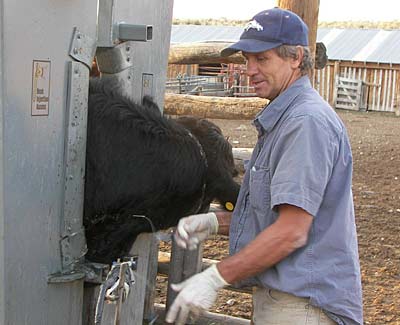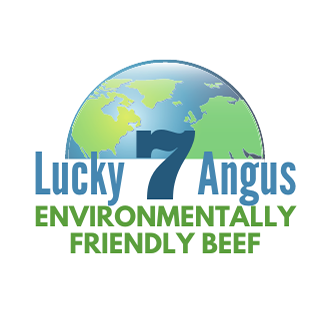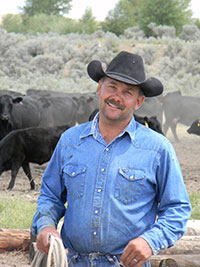PAP Testing
Q & A for High Elevation/PAP testing
Lucky 7 Angus is recognized in the cattle industry as the PAP/High Elevation expert. Not the expert like Dr. Tim Holt, DVM who makes a living PAP testing, but as the real world expert. The Jensen Family has raised cattle at elevations above 7000 feet since 1895, giving them the blood sweat and tears of knowledge concerning Brisket Disease for over 120 years. Lucky 7 Angus has tested more bulls above 7000 feet with greater exposures than any other seedstock producer (75 days and longer) (Over 6000 head PAP tested above 7000 feet). Lucky 7 Angus was at the forefront when Dr. Holt started PAP testing, and they have over 25 years of experience PAP Testing, along with countless hours of research and study. Lucky 7 Angus was the first seedstock program to have minimum standards PAP Testing. Dr. Holt has stated many times that Lucky 7 Angus takes PAP Testing to a higher level than any other seedstock producer.
Because of our transparency, knowledge, integrity and the above known facts, we have been interviewed by numerous cattle publications and radio shows as the real world expert in High Elevation/PAP Testing. We do not get paid to perform a PAP test, and we don't work for, nor get controlled by a University. Thus, my answers will be very direct, transparent and non-political. I welcome any feedback and other questions to add to this page.
Q: What is Brisket Disease and how does PAP testing work?
A: (Please click to PAP information section)
Q: At what elevation does Brisket Disease become an economic factor?
A: Brisket Disease can be a factor at any elevation. At low elevations it is a factor mainly in feedlots and known as right heart failure. What lucky 7 Angus deals with is High Elevation Disease, which becomes an economic factor to a ranch at elevations of around 6800 feet and higher. (This has been conveyed many times by Dr. Holt.)
Q: What elevation does a PAP test need to be performed to be useful for ranchers above 6800 feet?
A: 6400 feet elevation is what Dr. Holt and I believe is the minimum Elevation a PAP test must be performed in order to be a meaningful tool to high elevation ranchers 6800 feet and above. The higher the elevation of the PAP test, the more reliable. PAP tests above 7000 feet are better, and PAP tests above 7500 feet are exceptional (No PAP test is valid if the animal's exposure time to the elevation is less than 21 days).
Q: How many days exposure time to the elevation is necessary when PAP testing?
A: At 21 days exposure, a few animals may show higher mmHg pressure readings, but 42 days should be the minimum exposure time. The longer the exposure time the more reliable the score will be. 63 + days exposure time is what is recommended for high elevation ranchers. Exposure times of 90 days and longer to the elevation are almost 100% reliable. 21 days and less = 0% reliable, 21- 42 days = 33-50% reliable, 42-75 days = 50-75% reliable, 90 days and longer = Extremely Reliable, up to 95%. (The above exposure information is only valid on legitimate high elevation PAP testing above 6400 feet.)
Q: Do PAP tests performed below 6400 feet help in any way for high elevation ranchers?
A: Yes, but it very little. PAP testing at lower elevations will weed out a few animals as they will have high PAP scores. Dr. Holt conveys that PAP scores performed at 5-6400 feet will have a 70% chance of repeatability, or accuracy. (This accuracy is actually closer to 66%). Sounds pretty good, but here is the facts; Knowing that all cattle raised at elevations lower than 6400 feet have a 50% chance of being ok at high elevations without any PAP data. Your low elevation PAP only raised your chances by 16%. In laymen terms: If you buy 6 bulls from low elevation breeders without a PAP test, 3 will die. Whereas if you buy them with a PAP test below 6400 feet, only 2 will die(this will be paralleled in their offspring).
Q: Does the elevation of the cow herd make any difference?
A: Absolutely! Cattle have a unique ability to survive, and will adapt to conditions and elevations. Any cow herds living above 6800 feet for 8 months per year and longer will adapt to high elevations and their offspring will be infinitely more apt to survive at high elevations. Dr. Holt has confirmed that to me, and our experience with having other ranches at elevations below 5000 feet has totally confirmed this. True high elevation genetics are created by high elevation cow herds and are confirmed with legitimate PAP Testing!
Q: Will the PAP EPD be a useful tool to high elevation ranchers?
A: No. There are very few PAP scores turned into the EPD Angus data base system that are performed legitimately, above 6400 feet and longer than 42 days exposure time! When I spoke to Dr. Holt during PAP testing, 9/09/18, he said he did not think it would ever be a useful tool. "Garbage in= Garbage out!" Lucky 7 Angus knows of no PAP Data being turned in that was performed above 6400 feet and with 42 plus days of exposure to that elevation.
Q: How effective is PAP testing in reducing Brisket/High Mountain Disease?
A: PAP Testing is just one tool that will help. Even with an accurate and reliable PAP Test (above 7000 feet, and 75 or more days exposure) a PAP score will only correlate to the animals genetic ability 66% of the time or less, leaving 33% or more animals that will either have a Low PAP score and be genetically predisposed to brisket disease at elevation, or have a High PAP score and be genetically predisposed to do fine at elevation, all of which will directly affect their offspring. Brisket or High Mountain Disease is 42-84% heritable and thus, by locating and removing the genetics that cause the disease, it can be greatly reduced. With legitimate PAP Testing, tough culling pressure and running the cow herd above 7000 feet the following was possible: Lucky 7 Angus runs 3000 head of cows, calves and yearlings above 7000 feet per year, a minimum of 5 months and through a critical stress period (extreme cold and fluctuating temperatures). The last 2 years we have not lost a single animal to Brisket Disease at high elevation. We ran all replacement heifers above 10,000 feet and 4 did not come home. It is big country and we never found them...bears, wolves??
Q: Will they find a DNA marker for high elevation disease?
A: Not Likely. Two things that make it very unlikely; Both Dr. Holt's and our studies prove there are many factors that affect a PAP score/Brisket Disease making it almost impossible to find a single marker. The second reason is that almost all DNA markers, the industry claims they have now, are not marker types at all. Rather, they are DNA parentage results. They confirm parentage and then use the EPD data base of those parents. This was confirmed to me by an Angus Rep. It was confirmed a second time when I asked what would happen if I turned in a Charolaise cow's DNA to the Angus system. I was told it would kick the result out, as there is no parentage to verify it. Sorry folks, all breeds of cattle are from the species bovine, if a DNA marker is found it will cross with all bovine breeds. Ask a Scientist. DNA is not 100% accurate yet on almost all traits in the cattle industry including parentage.
Q: Can Right Heart failure in a feedlot be reduced with high elevation PAP Testing?
A: Yes! Right Heart Failure in feedlots is the biggest economic problem in today's feedlot with consistent losses of 10% and growing. At this point in time it has not been proven that high elevation PAP testing finds the same genetic probability that cause right heart failure in feedlots, but Dr. Tim Holt strongly believes it will. More research is necessary for an absolute conclusion. However, just by locating the outliers, high elevation PAP testing will eliminate a minimum of 15-20% of these deaths.
General Information

Any cattlemen running cattle at elevations above 5000 feet need to be aware of a condition known as Brisket Disease. Brisket Disease, also known as High Mountain Disease or Dropsy, is one of the Rocky Mountain Region’s most costly diseases with instances up to a 30% death loss. Brisket Disease can be associated with abortions, dead calves at birth, peewee calves at weaning, and the most commonly distinguished symptom, retained fluid in the chest area and eventually death. Although Brisket disease has been diagnosed at lower elevations, it becomes an economic impact to ranchers generally at 6800 feet elevation and above.
Cattle differ in how they respond to the availability of oxygen associated with a raise in elevation. In order to handle the lack of oxygen, cattle will respond by constricting vessels, in order to push blood through more area of the lung in order to gather more oxygen. The exercise of these vessels constricting causes the walls of the arteries in their lungs to thicken, such as a muscle becoming larger from weight lifting. This causes the heart to pump harder in order to get enough blood through the thickened arteries of the lungs. If these conditions become too acute, the heart will actually pump hard enough to push fluid through the walls of the pulmonary artery and blood vessels. This fluid is what causes the swelling of the chest in cattle with Brisket Disease. The heart will work hard enough that it can eventually wear out, and the animal will die of heart failure.
Research has shown the thickening of the walls of the arteries, which causes Brisket Disease, to be highly heritable. This means it can be controlled with proper genetic management. There are two ways to stop susceptibility to Brisket. The first is natural selection. When cattle are ran at higher elevations (above 6800 feet) for extended periods of time the disease will take it’s toll. Many cattle will be culled by mortality, while others will be culled by being open, dry, or from poor performance (individually and by their offspring). It is common practice for many cattlemen to run cattle in higher elevations for only the warm summer months. In this case you must be aware that Brisket problems may not show up. Cattle ran for short periods of time at elevations below 8500 feet with no stress, such as severe cold, will not always allow natural selection to occur.
The second method used to control Brisket Disease is Pulmonary Arterial Pressures (PAP) testing. PAP scores are obtained by a procedure called “right heart/pulmonary artery catheterization”. Where a catheter is passed through the jugular vein to the right ventricle of the heart, through a valve and into the pulmonary artery. At this point, a true average pressure is measured in millimeters of mercury (mmHg). In order for PAP scores to be accurate, the cattle must be at higher elevations for a minimum of 21 days. Other criteria to be considered when PAP testing are; PAP tests below 5000 feet will not predict cattle that are able to go to higher elevations. To be most accurate for cattle going to higher elevations, PAP tests must be performed above 6800 feet. Any cattle PAP tested below 6800 feet will need to be retested if they go to a higher elevation.
Using natural selection in your cow herd to eliminate cattle susceptible in your herd and requiring all new genetics(your bulls) to be properly PAP tested is a very effective way to control Brisket Disease. When evaluating PAP scores that will work for your operation, you must consider the animals age, the elevation of the PAP test and the elevation of your own cattle. PAP tests on young animals (9-12 months of age) are not recommended, but they seem to be fairly accurate(90-94%) to go to high elevations if the test is above 6800 feet and you use parameters of 35-41mmHg. Cattle tested at 12 months will generally score 1-2mmHg lower than cattle that are 18 months old and older. Also cattle PAP scores will generally raise 1-2 mmHg/1000 feet raise in elevation.
PAP testing is a tool that when used correctly can increase profits in high elevation operations. However you must request answers to these questions if you truly want PAP tests to work for you. What is the elevation of the test? How long was the animal at the elevation prior to the test? And what was the animals age? With out answers to these questions, PAP scores can not be properly evaluated.
This article was written in lay-mans terms to better help high elevation cattlemen. With consulting and approval by Dr. Tim Holt D.V.M., an expert in the field of Brisket Disease and PAP testing.
LUCKY 7 ANGUS MINIMUM REQUIREMENTS FOR PAP TESTING
- Animal must be at elevation of PAP test for a minimum of 45 days, but 120 days is recommended. (Lucky 7 Angus bulls are PAP tested at 7580 ft. after more than 4 months at elevation.)
- PAP test must be performed at a minimum of 6800 feet elevation.
- PAP test must be performed by Dr.Tim Holt D.V.M., or by a Veterinarian trained by and verified by Dr. Tim Holt D.V.M.
- Cow herd must be above 7000 ft. at least 5 months of the year and during a stress period, fall/weaning and cold part of winter. (Lucky 7 cow herd is above 7000 ft. 8 months May-December with no supplements.)
“Although a PAP test performed below 6800’ may be accurate in itself. It will not accurately predict cattle not prone to brisket above 6800’.”
Quick Links
Sale First Saturday in March!
Sale Date
March 7, 2026
WYDOT Travel Information Service




"Even though we are a five generation family ranch, we understand that to stay in business we have to become better businessmen. Live cattle futures and corn futures will control how much your calves are worth, and you need to understand their importance."




